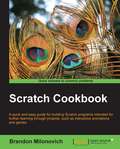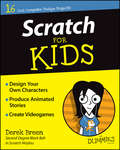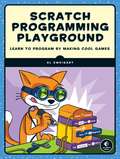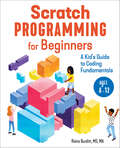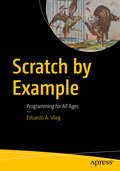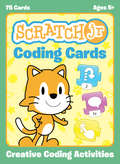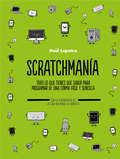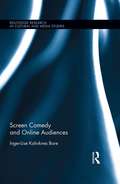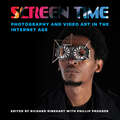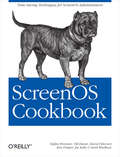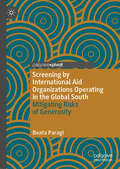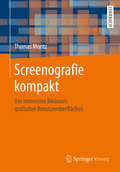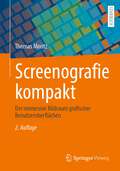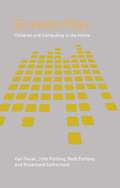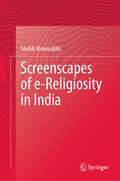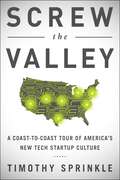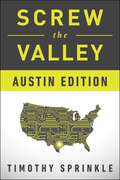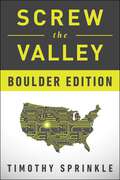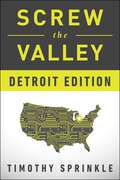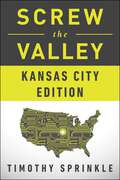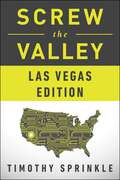- Table View
- List View
Scratch 3 Programming Playground: Learn to Program by Making Cool Games
by Al SweigartA project-filled introduction to coding that shows kids how to build programs by making cool games. Scratch, the colorful drag-and-drop programming language, is used by millions of first-time learners worldwide. Scratch 3 features an updated interface, new programming blocks, and the ability to run on tablets and smartphones, so you can learn how to code on the go.In Scratch 3 Programming Playground, you'll learn to code by making cool games. Get ready to destroy asteroids, shoot hoops, and slice and dice fruit! Each game includes easy-to-follow instructions with full-color images, review questions, and creative coding challenges to make the game your own. Want to add more levels or a cheat code? No problem, just write some code.You'll learn to make games like: • Maze Runner: escape the maze! • Snaaaaaake: gobble apples and avoid your own tail • Asteroid Breaker: smash space rocks • Fruit Slicer: a Fruit Ninja clone • Brick Breaker: a remake of Breakout, the brick-breaking classic • Platformer: a game inspired by Super Mario BrosLearning how to program shouldn't be dry and dreary. With Scratch 3 Programming Playground, you'll make a game of it!Covers: Scratch 3
Scratch Cookbook
by Brandon MilonovichA practical approach with hands-on recipes to learn more about Scratch and its features.Scratch Cookbook is great for people who are still relatively new to programming but wish to learn more. It assumes you know the basics of computer operation. The methods of using Scratch are worked through quickly with a focus on more advanced topics, though readers can move at their own pace to learn all the techniques they need.
Scratch For Kids For Dummies
by Derek Breenpublish it online--all with the click of a button.Create games, stories, and animationsLearn programmingShare your projects with the Scratch communityParticipate in the Scratch forumsIf you're looking to make the most of MIT's Scratch software but don't quite know where to start, everything you need to try your hand at this popular multimedia programming tool is right here. So what are you waiting for?
Scratch Programming Playground: Learn to Program by Making Cool Games
by Al SweigartScratch, the colorful drag-and-drop programming language, is used by millions of first-time learners, and in Scratch Programming Playground, you’ll learn to program by making cool games. Get ready to destroy asteroids, shoot hoops, and slice and dice fruit!Each game includes easy-to-follow instructions, review questions, and creative coding challenges to make the game your own. Want to add more levels or a cheat code? No problem, just write some code.You’ll learn to make games like:–Maze Runner: escape the maze!–Snaaaaaake: gobble apples and avoid your own tail–Asteroid Breaker: smash space rocks–Fruit Slicer: a Fruit Ninja clone–Brick Breaker: a remake of Breakout, the brick-breaking classic–Platformer: a game inspired by Super Mario Bros.Learning how to program shouldn’t be dry and dreary. With Scratch Programming Playground, you’ll make a game of it!Uses Scratch 2
Scratch Programming for Beginners: A Kid's Guide to Coding Fundamentals
by Raina BurdittThink like a coder—the fun guide to Scratch programming for ages 8-12Scratch is a visual computer language designed especially for kids, and Scratch Programming for Beginners is the perfect book to introduce kids to coding! It explains the fundamental concepts of Scratch in a kid-friendly way, and comes jam-packed with fun, creative activities.This book starts with the scratch programming basics, teaching kids what coding is, and all about the different tools they can use to build their own programs and games. Each chapter teaches a different aspect of coding, with exercises that get more challenging as they go, so kids can test their abilities and unleash their imagination. They'll even build their own game where they'll fight off a fire-breathing dragon!Inside Scratch Programming for Beginners, you'll find:No coding experience needed—This book is designed for coding beginners, with kid-friendly explanations, step-by-step instructions, and lots of pictures.Build a coding toolbox—Kids will build their own toolbox of skills, learning how to install and use Scratch, how to troubleshoot any pesky coding bugs with the Bug-Hunting Guide, and practice their Scratch programming lingo with a glossary of computer terms.Why Scratch?—Scratch uses blocks of code that fit together like puzzle pieces, so kids can watch how their code affects the program as they're building it. The fundamentals they'll learn in this book apply to other coding languages, too!Give kids the tools to build anything they can dream up, with a starter guide to scratch programming.
Scratch by Example
by Eduardo A. VliegThis is a book about learning the Scratch language so that you can use it in teaching and other instructional situations. The book explains the visual nature of the language, showing you how to write programs by dragging and dropping visual blocks representing common compute operations. Scratch is visual language that even young children can master. and makes computer programming as easy as dragging and dropping graphical blocks that represent programming commands, eliminating the traditional stumbling blocks of typing and syntax errors. With a drag-and-drop interface that runs in any web browser, and on devices from iPads to PCs to Macs to Microsoft Surface tablets, Scratch is an easily accessible way to enter the world of computer programming. This book teaches how to use Scratch in a fun and simple way that relies on examples and learning by doing. Progressing from simple three-block scripts that move a character across the screen to complex projects that involve motion, sound, and user input, this book:Imparts a thorough understanding of the Scratch interface.Shows how to create a range of Scratch projects, including simple games.Builds a solid foundation for future programming in other languagesWhat You Will LearnNavigate the Scratch interfaceCreate sprites and backdropsLearn programming skills good in all languagesProgram simple games and animationsShare programs with friends worldwideWho This Book Is ForScratch for Absolute Beginners is intended for complete beginners to the world of computer programming and the Scratch language. Learning to program in Scratch is an easy and fun way for anybody seven years and older to learn about computer programming. Scratch's drag-and-drop interface in a web browser makes the book easy and accessible to young children and adults alike.
ScratchJr Coding Cards: Creative Coding Activities
by Amanda Sullivan Marina Umaschi BersThe ScratchJr Coding Cards are a deck of 75 activity cards covering fun and exciting projects designed to educate young children with the visual programming language, ScratchJr.ScratchJr is a free, introductory computer programming language that runs on iPads, Android tablets, Amazon tablets, and Chromebooks. Derived from Scratch, the wildly popular programming language used by millions of kids worldwide, ScratchJr helps even younger children (5 to 7 years old) create their own playful animations, interactive stories, and dynamic games.The ScratchJr Coding Cards encourage kids to think creatively and systematically while developing computational thinking skills. Kids will learn powerful ideas about computer science by using ScratchJr programming blocks to make characters move, jump, dance, sing, and more. As they work through the deck, they will become creative thinkers and problem solvers.Written by the ScratchJr co-creator, Prof. Marina Umaschi Bers, and Dr. Amanda Sullivan, the exercises in ScratchJr Coding Cards will encourage kids to develop coding skills as well as foundational concepts for literacy, math, planning, and problem-solving, all while having fun. The cards are created using the pedagogical approach developed by Prof. Bers to teach coding in a playful way to young children.
Scratchmanía
by Raúl Lapeira¡Scratch, la programación al alcance de los más pequeños, de la mano de los máximos expertos en España! Scratch es el lenguaje de programación visual más sencillo con el que los niños podrán dar sus primeros pasos sin tener un conocimiento profundo de código. El libro combina la teoría y explicación sobre lo que es el scratch, a la vez que plantea proyectos sencillos para llevar a cabo utilizando la herramienta que se ha estudiado en un comienzo.
Screen Comedy and Online Audiences (Routledge Research in Cultural and Media Studies)
by Inger-Lise Kalviknes BoreThe question of why we laugh (or don't laugh) has intrigued scholars since antiquity. This book contributes to that debate by exploring how we evaluate screen comedy. What kinds of criteria do we use to judge films and TV shows that are meant to be funny? And what might that have to do with our social and cultural backgrounds, or with wider cultural ideas about film, TV, comedy, quality and entertainment? The book examines these questions through a study of audience responses posted to online facilities such as Twitter, Facebook, review sites, blogs and message boards. Bore’s analysis of these responses considers a broad range of issues, including how audiences perceive the idea of "national" comedy; what they think of female comedians; how they evaluate romcoms, sitcoms and web comedy; what they think is acceptable to joke about; what comedy fans get excited about; how fans interact with star comedians; and what comedy viewers really despise. The book demonstrates some of the ways in which we can adapt theories of humour and comedy to examine the practices of contemporary screen audiences, while offering new insights into how they negotiate the opportunities and constrictions of different online facilities to share their views and experiences.
Screen Ecologies: Art, Media, and the Environment in the Asia-Pacific Region
by Linda Williams Sarah Pink Larissa Hjorth Kristen SharpImages of environmental disaster and degradation have become part of our everyday media diet. This visual culture focusing on environmental deterioration represents a wider recognition of the political, economic, and cultural forces that are responsible for our ongoing environmental crisis. And yet efforts to raise awareness about environmental issues through digital and visual media are riddled with irony, because the resource extraction, manufacturing, transportation, and waste associated with digital devices contribute to environmental damage and climate change. Screen Ecologies examines the relationship of media, art, and climate change in the Asia-Pacific region -- a key site of both environmental degradation and the production and consumption of climate-aware screen art and media.Screen Ecologies shows how new media and visual artists provide alternative ways for understanding the entanglements of media and the environment in the Asia-Pacific. It investigates such topics as artists' exploration of alternative ways to represent the environment; regional stories of media innovation and climate change; the tensions between amateur and professional art; the emergence of biennials, triennials, and new arts organizations; the theme of water in regional art; new models for networked collaboration; and social media's move from private to public realms. A generous selection of illustrations shows a range of artist's projects.
Screen Ecologies: Art, Media, and the Environment in the Asia-Pacific Region (Leonardo)
by Linda Williams Sarah Pink Larissa Hjorth Kristen SharpHow new media and visual artists provide alternative ways for understanding and visualizing the entanglements of media and the environment in the Asia-Pacific.Images of environmental disaster and degradation have become part of our everyday media diet. This visual culture focusing on environmental deterioration represents a wider recognition of the political, economic, and cultural forces that are responsible for our ongoing environmental crisis. And yet efforts to raise awareness about environmental issues through digital and visual media are riddled with irony, because the resource extraction, manufacturing, transportation, and waste associated with digital devices contribute to environmental damage and climate change. Screen Ecologies examines the relationship of media, art, and climate change in the Asia-Pacific region—a key site of both environmental degradation and the production and consumption of climate-aware screen art and media.Screen Ecologies shows how new media and visual artists provide alternative ways for understanding the entanglements of media and the environment in the Asia-Pacific. It investigates such topics as artists' exploration of alternative ways to represent the environment; regional stories of media innovation and climate change; the tensions between amateur and professional art; the emergence of biennials, triennials, and new arts organizations; the theme of water in regional art; new models for networked collaboration; and social media's move from private to public realms. A generous selection of illustrations shows a range of artist's projects.
Screen Time: Photography and Video Art in the Internet Age
by Richard Rinehart and Phillip ProdgerPublished on the occasion of the art exhibition Screen Time: Photography and Video Art in the Internet Age, this catalog features a selection of leading international artists who engage with and critique the role of media in contemporary society. Their work demonstrates what has become known as post-internet artistic practices—art that may or may not be made for the internet but nevertheless acknowledges online culture as an omnipresent influence, inseparable from contemporary social conditions. They ask what it means to be a photographer when everyone is an Instagram influencer; what it means to make video art when everyone is a TikTok video star; and how to deliver meaningful social commentary in the age of the meme. The exhibition and accompanying catalog showcase artwork by N. Dash, Nathalie Djurberg, Marcel Dzama, Peter Funch, Cyrus Kabiru, William Kentridge, Christian Marclay, Marilyn Minter, Vik Muniz, Otobong Nkanga, Erwin Olaf, Robin Rhode, Vee Speers, Mary Sue, Puck Verkade, Huang Yan. Published by Bucknell University Press for the Samek Art Museum. Distributed worldwide by Rutgers University Press.
ScreenOS Cookbook
by Stefan BrunnerWritten by key members of Juniper Network's ScreenOS development team, this one-of-a-kind Cookbook helps you troubleshoot secure networks that run ScreenOS firewall appliances. Scores of recipes address a wide range of security issues, provide step-by-step solutions, and include discussions of why the recipes work, so you can easily set up and keep ScreenOS systems on track. ScreenOS Cookbook gives you real-world fixes, techniques, and configurations that save time -- not hypothetical situations out of a textbook. The book comes directly from the experience of engineers who have seen and fixed every conceivable ScreenOS network topology, from small branch office firewalls to appliances for large core enterprise and government, to the heavy duty protocol driven service provider network. Its easy-to-follow format enables you to find the topic and specific recipe you need right away and match it to your network and security issue. Topics include: * Configuring and managing ScreenOS firewalls * NTP (Network Time Protocol) * Interfaces, Zones, and Virtual Routers * Mitigating Denial of Service Attacks * DDNS, DNS, and DHCP * IP Routing * Policy-Based Routing * Elements of Policies * Authentication * Application Layer Gateway (SIP, H323, RPC, RTSP, etc.,) * Content Security * Managing Firewall Policies * IPSEC VPN * RIP, OSPF, BGP, and NSRP * Multicast -- IGPM, PIM, Static Mroutes * Wireless Along with the usage and troubleshooting recipes, you will also find plenty of tricks, special considerations, ramifications, and general discussions of interesting tangents and network extrapolation. For the accurate, hard-nosed information you require to get your ScreenOS firewall network secure and operating smoothly , no book matches ScreenOS Cookbook.
ScreenOS Cookbook: Time-Saving Techniques for ScreenOS Administrators
by Stefan Brunner Vik Davar David Delcourt Ken Draper Joe Kelly Sunil WadhwaWritten by key members of Juniper Network's ScreenOS development team, this one-of-a-kind Cookbook helps you troubleshoot secure networks that run ScreenOS firewall appliances. Scores of recipes address a wide range of security issues, provide step-by-step solutions, and include discussions of why the recipes work, so you can easily set up and keep ScreenOS systems on track.ScreenOS Cookbook gives you real-world fixes, techniques, and configurations that save time -- not hypothetical situations out of a textbook. The book comes directly from the experience of engineers who have seen and fixed every conceivable ScreenOS network topology, from small branch office firewalls to appliances for large core enterprise and government, to the heavy duty protocol driven service provider network. Its easy-to-follow format enables you to find the topic and specific recipe you need right away and match it to your network and security issue.Topics include:Configuring and managing ScreenOS firewallsNTP (Network Time Protocol)Interfaces, Zones, and Virtual RoutersMitigating Denial of Service AttacksDDNS, DNS, and DHCPIP RoutingPolicy-Based RoutingElements of PoliciesAuthenticationApplication Layer Gateway (SIP, H323, RPC, RTSP, etc.,)Content SecurityManaging Firewall PoliciesIPSEC VPNRIP, OSPF, BGP, and NSRPMulticast -- IGPM, PIM, Static MroutesWirelessAlong with the usage and troubleshooting recipes, you will also find plenty of tricks, special considerations, ramifications, and general discussions of interesting tangents and network extrapolation. For the accurate, hard-nosed information you require to get your ScreenOS firewall network secure and operating smoothly , no book matches ScreenOS Cookbook.
Screening by International Aid Organizations Operating in the Global South: Mitigating Risks of Generosity
by Beata ParagiAid organizations usually embrace the idea of digitalization, both in terms of using diverse technologies and processing data digitally for improving their services, making their operations more efficient and even mitigating various risks. While digital fundraising, the use of biometric ID systems or digitalized cash and voucher assistance enjoys widespread attention both in academic and practitioner circles, it is less known how aid organizations navigate between counterterrorism legislations and data protection laws in technical terms. Limiting the discussion to the EU General Data Protection Regulation and by conceptualizing screening — commonly used to prevent the use of donor money for illicit purposes, money-laundering, terrorism finance or corruption — as a data processing operation conducted by larger international aid organizations operating in the Global South, this book focuses on the matter of ‘transparency’ and ‘right to information’ being at the nexus ofsurveillance studies and privacy studies. By means of legal and social science methods, it simultaneously explores screening in light of classic surveillance and analyses whether opacity around screening by NGOs (data controllers) is in line with the spirit of European Union data protection regime from the perspective of individuals (data subjects). In so doing, Paragi also contributes to the discussion on the politics of transparency and highlights the dilemmas and challenges aid organizations operating in authoritarian regimes or conflict settings may face.
Screenografie kompakt: Der immersive Bildraum grafischer Benutzeroberflächen
by Thomas MoritzDieses Buch behandelt die Screenografie von grafischen Benutzeroberflächen basierend auf einem didaktisch strukturierten Lehrprogramm, dessen Kapitel inhaltlich aufeinander aufbauen und jeweils in einem zusammenfassenden Fazit enden. Nach einer einführenden thematischen Motivation werden wahrnehmungspsychologische und kommunikationswissenschaftliche Grundlagen des Systemischen Designs erläutert, dessen Spezifik für die systematische Entwicklung grafischer Benutzeroberflächen essentiell ist. Im Kontext immersiver Raumnutzung wird u.a. illustriert, wie ein Screen morphologisch in kleinere geometrische Einheiten unterteilbar ist, die als visuelles Ganzes die ideale Basis für ein visuelles Gestaltungsraster bilden, welches den immersiven Bildraum strukturiert und organisiert. Es werden nutzerspezifische Farbgebungen für ein visuelles Ambiente aufgezeigt, das einem speziellen Nutzernaturell entspricht, da es auf Erfahrungen mit natürlichen Umgebungen basiert und über alle geografischen und ethnologischen Grenzen hinweg stimuliert und zur interaktiven Nutzung motiviert.
Screenografie kompakt: Der immersive Bildraum grafischer Benutzeroberflächen
by Thomas MoritzDieses Lehrprogramm zur systematischen Gestaltung eines interaktiv nutzbaren Bildschirms (Screen) erläutert wahrnehmungspsychologische und kommunikationswissenschaftliche Grundlagen, die für das Systemische Design grafischer Benutzeroberflächen (Graphical User Interfaces) relevant sind. Im Kontext interaktiver Raumnutzung wird illustriert, wie die Bildschirmfläche morphologisch in Form eines visuellen Gestaltungsrasters (Visual Design Pattern) zu gliedern ist, das den immersiven Bildraum der grafischen Benutzeroberfläche strukturiert und die interaktive Nutzung erleichtert. Es werden mögliche Farbkombinationen für ein visuelles Ambiente definiert, deren Wirkungsweise auf natürlichen Erfahrungswerten basiert und somit einem speziellen Nutzernaturell entspricht, dessen Charakteristika weltweit identisch sind.
Screenplay: Children and Computing in the Home
by John Furlong Rosamund Sutherland Keri Facer Ruth FurlongWhat are young people really doing on computers at home?Computers feature heavily in the lives of today's young people, and this book sets out to question commonplace assumptions about the use of technology by children at home. Bringing together research from the perspective of psychology, sociology, education and media studies, the authors ask whether we are really witnessing the rise of a new 'digital generation'.Drawing upon the results of their in-depth research project, the authors filter and assess their findings accessibly, offering fascinating reading on:* how computers are used in the home* how parents and children negotiate access to and use of the computer* what role the computer plays in the day to day lives of families.This book makes use of illuminating case studies, and highlights key issues of concern around issues of equality and access in a wider social context. This truly interdisciplinary perspective will be instrumental in reshaping the understanding of teachers, ICT advisors, policy makers and all involved in ICT for children.
Screenscapes of e-Religiosity in India
by Shekh MoinuddinThis book deals with three different subjects: geography, social media and religion equally to discuss e-religiosity in terms of screenscapes that shaped digital socialization processes wherein the role of digital devices in general and smartphones in particular are considered crucial and critical. The spatial dimension is the primary foundation of the book wherein both space and place are discussed in digital manifestations in spatial sense. Religiosity is discussed variably in a sense of spirituality, social theories, religions and images. The book uses some illustrations to understand image politics. Image politics is quintessential in the age of digital technologies when production and reproduction of images are not restricted to business only; rather it attracts politics too and politicians often use the same to make political scores against opponents. The book covers contemporary digital discourses of e-religiosity in a sense of screenscapes that often found pivot in daily discussions across social media platforms. Screenscapes are considered as mediated technologies when contents can be accessed from different social media apps to construct or deconstruct their views, narratives, discourses, ideas, emotions, and perceptions around religious images in day-to-day activities, practices, rituals, customs, traditions, faiths and beliefs. The used illustrations exclusively map Indian religious gestures, identities, values, and rituals in digital-spatial contexts. The book discusses seven major questions and argues the same across the chapters in varied representations and interpretations: How and to what extent has the meaning of religiosity changed in the digital age? What are the dimensions of e-religiosity in India? How are digital devices (re)shaping religiosity in terms of e-religiosity? How and to what extent digital devices are negotiating with social and cultural lives? What is digital spatiality? How and to what extent does social media influence religiosity?
Screw the Valley: A Coast-to-Coast Tour of America's New Tech Startup Culture: New York, Boulder, Austin, Raleigh, Detroit, Las Vegas, Kansas City
by Timothy SprinkleThe most exciting high-tech startups are escaping the expensive and inbred environment of Silicon Valley. Welcome to the future. Entrepreneurs know they must embrace innovation to excel—starting with where they locate their new venture. Fortunately, budding companies seeking fertile ground have more options today than ever before. Screw the Valley calls on today's entrepreneurs and aspiring business owners to forget California and explore other options across the country—cities that offer more room to breathe, easier access to funding and talented workers, fewer heads to butt, and less money down the drain. Timothy Sprinkle visits seven areas that offer a superior landscape for tech startups: Detroit New York City Las Vegas Austin Kansas City Raleigh-Durham Boulder Sprinkle gives readers a window into the startup potential in each city, detailing which industries are thriving where, and highlighting the unique appeal and character of each location. Bright ideas are not geographically limited, and innovation is happening every day in cities all over the country. It's time to think outside the box when it comes to startup location. It's time to say Screw the Valley.
Screw the Valley: Austin Edition
by Timothy SprinkleIt's time to put the Valley in your rearview mirror. Destination: New Startup America. Next stop: Autsin. In this companion eBook to Screw the Valley, Timothy Sprinkle highlights Austin, one of seven cities that offers superior landscapes for tech startups. With brand new, city-specific content, an excerpt from Screw the Valley, and a compilation of the dynamic assets and support available to local startup founders and tech advocates, Screw the Valley: Austin Edition gives readers a glimpse into the startup potential of the Texas capital and the unique resources it has to offer. Bright ideas are not geographically limited, and innovation is happening every day in cities all over the country. It's time to think outside the box when it comes to startup location. It's time to say Screw the Valley.
Screw the Valley: Boulder Edition
by Timothy SprinkleIt's time to put the Valley in your rearview mirror. Destination: New Startup America. Next stop: Boulder. In this companion eBook to Screw the Valley, Timothy Sprinkle highlights Boulder, one of seven cities that offers superior landscapes for tech startups. With brand new, city-specific content, an excerpt from Screw the Valley, and a compilation of the dynamic assets and support available to local startup founders and tech advocates, Screw the Valley: Boulder Edition gives readers a glimpse into the startup potential of this city by the mountains and the unique resources it has to offer. Bright ideas are not geographically limited, and innovation is happening every day in cities all over the country. It's time to think outside the box when it comes to startup location. It's time to say Screw the Valley.
Screw the Valley: Detroit Edition
by Timothy SprinkleIt's time to put the Valley in your rearview mirror. Destination: New Startup America. Next stop: Detroit. In this companion eBook to Screw the Valley, Timothy Sprinkle highlights Detroit, one of seven cities that offers superior landscapes for tech startups. With brand new, city-specific content, an excerpt from Screw the Valley, and a compilation of the dynamic assets and support available to local startup founders and tech advocates, Screw the Valley: Detroit Edition gives readers a glimpse into the startup potential of "Motor City" and the unique resources it has to offer. Bright ideas are not geographically limited, and innovation is happening every day in cities all over the country. It's time to think outside the box when it comes to startup location. It's time to say Screw the Valley.
Screw the Valley: Kansas City Edition
by Timothy SprinkleIt's time to put the Valley in your rearview mirror. Destination: New Startup America. Next stop: Kansas City. In this companion eBook to Screw the Valley, Timothy Sprinkle highlights Kansas City, one of seven cities that offers superior landscapes for tech startups. With brand new, city-specific content, an excerpt from Screw the Valley, and a compilation of the dynamic assets and support available to local startup founders and tech advocates, Screw the Valley: Kansas City Edition gives readers a glimpse into the startup potential of the "City of Fountains" and the unique resources it has to offer. Bright ideas are not geographically limited, and innovation is happening every day in cities all over the country. It's time to think outside the box when it comes to startup location. It's time to say Screw the Valley.
Screw the Valley: Las Vegas Edition
by Timothy SprinkleIt's time to put the Valley in your rearview mirror. Destination: New Startup America. Next stop: Las Vegas. In this companion eBook to Screw the Valley, Timothy Sprinkle highlights Las Vegas, one of seven cities that offers superior landscapes for tech startups. With brand new, city-specific content, an excerpt from Screw the Valley, and a compilation of the dynamic assets and support available to local startup founders and tech advocates, Screw the Valley: Las Vegas Edition gives readers a glimpse into the startup potential of "Sin City" and the unique resources it has to offer. Bright ideas are not geographically limited, and innovation is happening every day in cities all over the country. It's time to think outside the box when it comes to startup location. It's time to say Screw the Valley.

